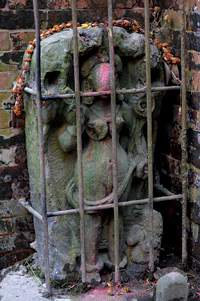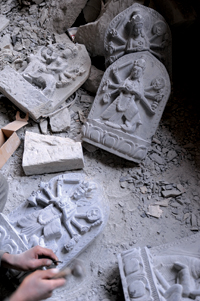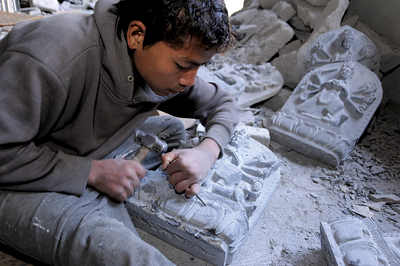According to the tradition of Nepali stone sculpting, Ganesh’s trunk is always curled towards his right. But there are examples of works in the market where the trunk is turned to the left. Such violations need to be addressed if we are to preserve the ancient (and renowned) art of stone carving in Nepal.

Master stonecarver Dharma Raj Shakya at work
In the compound of Arniko Stone Carving Factory, numerous slabs of stones are scattered. A sculptor is working with his hammer and chisel on a large black stone statue of Lord Ganesh. With every blow of the hammer and every notch made by the chisel, the countenance of Ganesh emerges from the rock, a centimeter at a time. The rock seems a doorway between heaven and earth from which Ganesh is arriving into the latter from the former. In another corner a statue of Vishnu, a replica of the one in the Budanilkantha Temple, lies on its back, perhaps resting for a period before it is housed in a temple and begins its full-time duty as a god.
The large blocks of stone strewn in the factory’s compound have been extracted from a quarry in Hattiban, which lies to the south of Kathmandu. Sculptors of the Kathmandu valley have used the stones from this quarry for ages. The quarry is situated in the Chandragiri hills, which run from the Makwanpur district to Godavari. Limestone from this area has been the favorite of sculptors of the Kathmandu valley. Rocks are selected on the basis of a number of traits: they must be black in color; they must be hard; and they need to be free of cracks.
Once these large stones are sculpted into the idols of gods and goddesses, they are usually placed in temples and shrines. And, they often occupy the altars for centuries. The statue of Gaja Laxmi at Chyasalhiti in Patan dates back 2,200 years. Deepawati Mahabihar, which is located in Patan’s Guitol, is believed to be 3,500 years old. There are stone statues in the Changu Narayan Temple that belong to the Licchavi Period, which stretched from the 5th century AD to the 17th century AD. Some statues in the Pashupatinath Temple complex were sculpted in the 6th century BC during the Kirat Period.
Numerous valuable works of stone were destroyed in the winter of 1349 when the marauding forces of Shamsud-din-Ilyas, the Muslim ruler of Bengal, entered Kathmandu. For a week, the army of iconoclasts attacked the major Hindu and Buddhist temples, destroying the sculptures placed in these religious sites. Fortunately, due to the efforts of some people, a few masterpieces of stone survived the Muslim attacks. One such sculpture was the famous statue of Vishnu, which now lies supine in the Budanilkantha Temple. To save the statue from the Muslims, some people buried it. The statue was saved but with the passage of time people forgot about it and it was lost. Then, one day a farmer struck something hard while plowing his field, which later turned out to be the toe of the Vishnu idol buried years ago.

An ancient stone idol
Limited hands
It is difficult to determine when stone sculpting started in Kathmandu, because sculptors never etched their names or dates on their works. Dharma Shakya, owner of Arniko Stone Carving, considers the biggest impetus to stone sculpting came in the 6th century of the Bikram Sambat (BS), when the Rudra Varna Mahabihar was built in Patan. It was a locality of artisans, where families of artists and craftsmen could live and work. Stone sculpting, along with other forms of traditional art, began to flourish in this village of artists.
Stone sculpting has historically been a profession that is passed down from father to son. For stone sculptors, like numerous other forms of traditional art, the home was the shop as well as the school. Dharma Shakya’s family has been in the profession of stone sculpting for more than 500 years. He is a descendent of Abhaya Raj Shakya, who built the Mahaboudha Temple in the 16th century BS, and was the royal artist in those days. Dharma Shakya learned stone sculpting from his father, who taught stone sculpting at the Lalit Kala Campus. Shakya started as an assistant to his father. He acquired the basic skills of sculpting under the tutelage of his father and through the hours he spent watching his father at work. But the opportunities to hone his skills came when his father couldn’t be in the shop with him. “When my father was out teaching, clients who had ordered something with my father came to our house asking for their order. Since my father was busy, I had to work on some of the sculptures in order to complete them on time. In this way I started working more and more and became a better sculptor,” recalls Shakya.
Despite being a profession that is centuries old, stone sculpting has never had a large number of practitioners. Sculptors have always been few in number. Practiced in the confines of the house and transferred in most cases from father to son, the skills of the art have been inaccessible to most. By 1990, the number of families involved in stone sculpting had been reduced to around five. Fortunately, there was a gradual surge in interest and demand of stone sculptures in the years after 1990, and the number of sculptors also grew. “Today, there are around 16 families that practice stone sculpting as a profession in Kathmandu. This amounts to about 150 sculptors,” says Shakya.
He believes the very thing that propagated and ensured the passage of the art of stone sculpting from one generation to another is now pushing the profession into a cul-de-sac. “The tradition of teaching the art of stone sculpting within a household poses a problem for those people who want to learn the art but don’t have a family member practicing it. This ultimately creates a situation where the art will suffer because those who can teach are not accessible to those who want to learn,” says Shakya. He fears that his generation of stone sculptors may not have someone in their family to pass on their skill to.
Shakya believes the time has come to start imparting the skill of stone sculpting outside the family circle. Although there are three colleges – Srijana College of Fine Arts, Kathmandu University’s School of Fine Arts, and Lalit Kala Campus – offering degrees in fine arts in Nepal, none of them have a course in stone sculpting. This, coupled with the fact that many children of stone sculptors are opting for careers outside of their family profession, has created a dearth of practitioners in this form of art. “If we are to preserve this form of art we need to have institutions that teach it,” says Shakya.
Beside the preservation of the art, Shakya is also annoyed by the appearance of sculptures in the market that violate the traditional rules of sculpting. “Today, whatever that has a trunk is a Ganesh,” he says sarcastically. According to the tradition of Nepali stone sculpting, Ganesh’s trunk is always curled towards his right. But there are examples, Shakya says, of works in the market where the trunk is turned to the left.

Traditional form of stone carving requires a degree of erudition that comes only through years of study and practice
An Esoteric Trade
To understand the principles governing stone sculpting, it is necessary to know its different forms. There are two major classifications of stone sculpting in Nepal: traditional and modern. Statues of gods, linga (phallus-shaped structures built in ode to Shiva), stone spigots, and other figures of stone found near temples and shrines such as nags (serpents), lions, oxen and garuda (a mythical bird) are all examples of the traditional form of stone sculpting. Since they are reproductions of forms and images that were first made centuries ago, the traditional form of stone sculpting is more rigid and does not allow for much experimentation. Creations that do not follow the old guidelines or are more than mere reproduction of ancient forms and design are called modern form of stone sculpting.
Modern stone sculpting is a difficult art form in itself but the traditional form requires a degree of erudition that comes only through years of study and practice. Stone sculpting, Shakya says, is not just cutting out the form of a god from stone. Since most stone sculptures in Nepal are those of gods, before someone takes a chisel and hammer in his hands, he must acquaint himself with religious tomes that describe the physical appearance and disposition of the gods in meticulous detail. There are guidelines on how to sculpt different idols and every sculptor must know and follow them. “We have to peruse religious texts to glean facts about different gods,” says Shakya.
Religious scriptures such as the Vishnu Puran, Shiva Puran and Garuda Puran contain detailed descriptions of Vishnu, Shiva, and Garuda, respectively. These are just three of the dozens of similar books on the many gods. Pratima Lachhin Bidhi, the most informative book on the physical features and physiognomy of the gods of the Hindu pantheon, is a stone sculptor’s bible. It describes everything from the color of the gods’ skins to their facial features to what gods wield in their hands. There are also mentions on the proportions of a sculpture. The sculptures of gods whose appearances resemble that of humans – for example, Shiva, Vishnu, Krishna, Laxmi – are sculpted by dividing the body from head to toe in seven-and-a-half parts. Gods like Ganesha and Bhairav, who do not completely have human features, are sculpted by dividing the body in five parts.
There are also guidelines on how to portray the gods in their different forms. The items in the hands of a Vishnu statue, for example, changes with the months of a year. Without a sound knowledge of the scriptures, it is not possible to determine what to place in the hands. Also, each article carried by the gods is symbolic. A conch, for instance, means that the god is delivering a message. A lotus in the hand means the god is in a calm state, whereas a chakra, which is a weapon, portrays the god in an aggressive mood, threatening retribution to wrong-doers. “Placing different objects in the hands of a statue reflects the philosophy that the gods will reward or punish according to how you lead your life,” explains Shakya.
One of the benefits of having his father as his teacher was that Shakya didn’t have to study entire volumes on gods and sculpting, which would take anyone a lifetime. Like most other things about stone sculpting, he learned the traditional rules and guidelines from his father. Beside his father, Shakya relied on another source for reference. “The old temples of Nepal contain works of a very high standard. Every time I visit these historical sites my knowledge of stone sculpting is renewed. The sculptors of the past seem to have endowed life to their works. The statues are alive,” says Shakya. It is that aliveness that craftsmen like Shakya pursue in their own works. “The ancient statues are reminders of the high standards that were set centuries ago. They inspire a sense of responsibility in me. Looking at them makes me want to replicate their beauty in whatever I create,” he says.
Shakya ranks the sculptures in the Changu Narayan Temple, the statue of the supine Vishnu at Budhanilkantha, the idols at Swyambhunath, the works in the Palanchowk Bhagwati temple, the ruins of a temple in Murtiya near Janakpur and the statues of Simraungadh as some of the best examples of stone sculptures in Nepal.

Stone sculpting is a hard and demanding craft
Stories in stone
The different rules to be followed in sculpting a god’s figure usually have their origins in mythology. There is a story that explains why all images of the elephant-headed Hindu god, Ganesh, shows him with one broken tusk. According to mythology, a priest once summoned all the gods at the Chobar gorge. He, however, forgot to call the Ganesh residing in the nearby Jal Binayak Temple. Angered by this indiscretion, Ganesh decided to punish the priest by razing the entire hillock on which he was meditating. The priest became aware of this plan and requested Bignantak Bhairav to come to his aid. A duel broke out between Ganesh and Bignantak Bhairav. During the fight Bignantak Bhairav broke one of Ganesh’s two tusks in half. From that day onwards, Ganesh is depicted in all drawings and statues with one-and-a-half tusks. “Sculpting is doing on rock what a novelist does on paper. Often it reveals something which people don’t even acquire after reading a book or attending lectures,” says Shakya.
Sculpting in Nepal is like writing a novel using pen and paper; sculptors are still working with old tools. Shakya believes that the stone art industry needs to use the available technology. I ask him if that will not take away an essential part of the process of sculpting. He tells me the machines will only be used to do the things that involve ordinary tasks such as cutting and polishing, not the artistic ones of etching details. “Machines will do only 25 per cent of the work; the rest needs to be done by hand,” he assures me. Using machines, he explains, will reduce the cost of producing a sculpture and enable sculptors to be more prolific.
Nepal’s stone sculptures, like literary masterpieces, have an enduring quality. “What our forefathers built centuries ago is bringing us dollars today,” says Shakya, referring to the revenue generated from tourists who visit the various sites in Kathmandu to see the stone sculptures. Sculptors like Shakya are continuing the craft of their forefathers, toiling with stone for days to create their own masterpieces. Stone sculpting rests in able hands and will live on in Nepal as long as there are rocks, and people who see the potential in a rock to become God.









